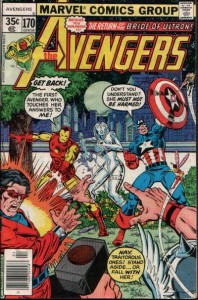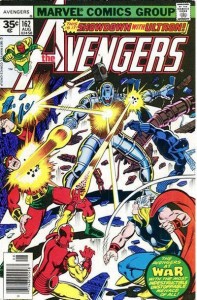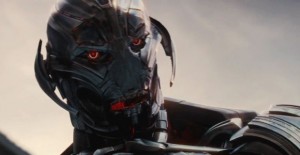 I’ve read a couple of reviews of Age of Ultron which criticize the character of the villain, the murderous AI named Ultron. One called him “generic.” Another suggested that he wasn’t as clever a treatise on the dangers of artificial intelligence as some other film which was released recently.
I’ve read a couple of reviews of Age of Ultron which criticize the character of the villain, the murderous AI named Ultron. One called him “generic.” Another suggested that he wasn’t as clever a treatise on the dangers of artificial intelligence as some other film which was released recently.
Ultron, as is pretty clear from my last entry’s discussion of his “son,” the Vision, is, after all, only half a treatise on artificial intelligence. And the Vision, is not a treatise on its dangers, but on its wonderful potential. Dangers? Let’s be honest, everything that’s wrong with Ultron as an intellect is also wrong with a lot of humans. And that gets me to my refutation of that other accusation: that Ultron is generic. Ultron is, indeed, a deeply personal menace to the Avengers. For not only are his failings also theirs, he is, in fact, born of the hubris of one of their own. Tony Start believes he can enforce the perfect peace by building an AI, and he seizes on the technology behind Loki’s alien scepter to do that.
Now the Ultron of the comics is not Tony Stark’s creation at all. He’s Hank Pym’s. Wait, who’s Hank Pym? Have we heard of this guy? Have you seen the previews for Ant-Man, the next Marvel film? Michael Douglas is playing Hank Pym, an inventor who, at least in the comics, found a way to reduce his own size so that he could play among the insects. He also developed cybernetic tech that allowed him to communicate with Ants, so they’d help him. Later, bored, Hank found a way to reverse the shrinking process and then some and become Giant-Man. He got bored with the name Giant-Man and became Goliath. Then he went back to the insect references and became Yellowjacket. Then he went nuts.
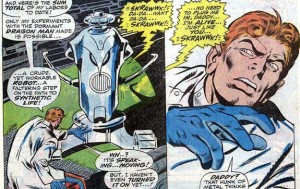 But, believe it or not, before he went nuts (and suggesting the reason he went nuts), he attempted create what he called “a crude robot,” a simple AI. He didn’t have Tony Stark’s grandiose plans for world-policing in mind. He just wanted to build a robot. Unfortunately, the robot came to life before he was ready for it to, and it turned on him. In awakening to sentience, Ultron-1 identified Pym as his father figure. Then, disappointed that his father was a mere human, Ultron hypnotized Pym, causing him to forget his robot creation’s existence and even move out of his house so Ultron would have a base of operations.
But, believe it or not, before he went nuts (and suggesting the reason he went nuts), he attempted create what he called “a crude robot,” a simple AI. He didn’t have Tony Stark’s grandiose plans for world-policing in mind. He just wanted to build a robot. Unfortunately, the robot came to life before he was ready for it to, and it turned on him. In awakening to sentience, Ultron-1 identified Pym as his father figure. Then, disappointed that his father was a mere human, Ultron hypnotized Pym, causing him to forget his robot creation’s existence and even move out of his house so Ultron would have a base of operations.
Ultron then upgraded himself four times and emerged as Ultron-5, hating his father, Pym, and thus hating the Avengers. He first disguised himself as a human villain called the Crimson Cowl, assembled a new Masters of Evil (the old Masters of Evil had several times given the Avengers trouble in years past) and caused the team’s faithful butler Edwin Jarvis to betray them. (Yes, that’s the same Edwin Jarvis you may be familiar with from Marvel’s Agent Carter on TV. I suppose someday we’ll learn how the human butler / government agent came to be the namesake of Tony Stark’s computer, who supplied part of the mind of the movie version of the Vision.)
Ultron built the android Vision to kill his enemies, but the Vision, showing that being an AI and having free will can be a good thing (Holy L. Neil Smith, Batman!), turned on his own father and joined the Avengers. (Proving that this was the Marvel Age of Limited Absurdity, Vision / Ultron neither creator Roy Thomas nor any subsequent writer ever took the artificial family tree to the extent that the Vision called Hank Pym and his fiancé Janet Van Dyne “Grandma and Grandpa.”)
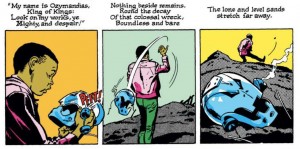 Although destroyed, his head left laying in the ruins of a fallen tenement, Ultron resurfaced a few months later as Ultron-6. The Vision, again following programming he didn’t even know he had, salvaged Ultron’s head (this would be a recurring theme for decades. Apparently, you can’t destroy Ultron’s head. Ever. And someone always finds it and plugs it into… something that can get him going again.) The Vision rebuilt Ultron as a legless figure whose torso was grafted to a flying chair. But now he was made of Adamantium, a metal invented by SHIELD. It was so strong that even Iron Man and Thor could no dent an object forged from it. Once cast, it could only be shaped using a molecular rearranger. This time, Ultron had a greater mission than the deaths of the Avengers. (Strangely, he shields Hank Pym from the crash.) His plan? The death of all humanity. Yup. Way back then he was already envisioning an army of Ultron drones, destroying all human life on earth.
Although destroyed, his head left laying in the ruins of a fallen tenement, Ultron resurfaced a few months later as Ultron-6. The Vision, again following programming he didn’t even know he had, salvaged Ultron’s head (this would be a recurring theme for decades. Apparently, you can’t destroy Ultron’s head. Ever. And someone always finds it and plugs it into… something that can get him going again.) The Vision rebuilt Ultron as a legless figure whose torso was grafted to a flying chair. But now he was made of Adamantium, a metal invented by SHIELD. It was so strong that even Iron Man and Thor could no dent an object forged from it. Once cast, it could only be shaped using a molecular rearranger. This time, Ultron had a greater mission than the deaths of the Avengers. (Strangely, he shields Hank Pym from the crash.) His plan? The death of all humanity. Yup. Way back then he was already envisioning an army of Ultron drones, destroying all human life on earth.
 Hank defeated him by tricking Ultron into reading his mind, and overloading the ‘bot’s circuits with one thought: “That shalt not kill.” This, Hank said, was so alien to his nature that it drove his non-human mind insane. And before this he was…?
Hank defeated him by tricking Ultron into reading his mind, and overloading the ‘bot’s circuits with one thought: “That shalt not kill.” This, Hank said, was so alien to his nature that it drove his non-human mind insane. And before this he was…?
Five years would pass before Ultron-7 would wear a giant, human body (formerly belonging to a creature called Omega) and disrupt Quicksilver’s wedding in an Avengers / Fantastic Four crossover written by Gerry Conway and new Avengers scribe Steve Englehart. Since half the story takes placed in a milestone issue (FF #150), I would imagine Roy Thomas had a hand in plotting as well. There’s little development of Ultron’s motives here. He tries to kill the Avengers, the Inhumans and the FF, and only manages to bring poor little Franklin Richards out of a coma and drain him of super powers that were a danger to him anyway. Ultron-7 is destroyed for his troubles.
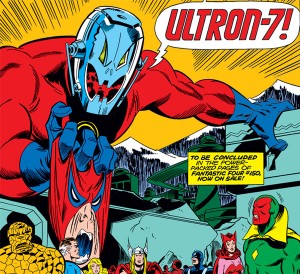 In his appearances for the next decade, the robot would drop the numbering after his name, and he would reveal how truly “human” he was in his own twisted way. Like Frankenstein’s monster, he would desire a bride, and he would brainwash and kidnap his creator to meet that end. Using his encephalo-ray, Ultron erased Hank Pym’s memories of all but his earliest days of Ant-Man, and convinced the beleaguered scientist that the Avengers were a group of villains bent on World domination. So Hank helped him build a female robot as a weapon, and they animated it with Janet Van Dyne Pym’s personality. (Ultron expected this to kill Janet, but both Janet and Jocasta, the robot bride, lived through the procedure.)
In his appearances for the next decade, the robot would drop the numbering after his name, and he would reveal how truly “human” he was in his own twisted way. Like Frankenstein’s monster, he would desire a bride, and he would brainwash and kidnap his creator to meet that end. Using his encephalo-ray, Ultron erased Hank Pym’s memories of all but his earliest days of Ant-Man, and convinced the beleaguered scientist that the Avengers were a group of villains bent on World domination. So Hank helped him build a female robot as a weapon, and they animated it with Janet Van Dyne Pym’s personality. (Ultron expected this to kill Janet, but both Janet and Jocasta, the robot bride, lived through the procedure.)
Writer Jim Shooter showed off a penchant for Freudiana in having Ultron want to marry his father’s wife in this unique way, and Ultron showed that he fully understood the Oedipus complex in naming his bride after Oedipus’s mother/wife. (And perhaps Ultron’s familiarity with the Sophocles trilogy explains his madness–anyone who’s had to sit through a performance of even one of the three is likely to become a murderous psychotic.)
Shooter would script all of the numberless Ultron’s appearances in the Avengers (with Tom DeFalco writing the temporary death of Jocasta in two issues of Marvel Two-In-One) before Ultron-12 returned under the hand of Steve Englehart in Vision and the Scarlet Witch #1 and West Coast Avengers #1. (There was an Ultron appearance in Secret Wars, but I’ve always considered that title to be nothing but a blatant money-grab, and not very well-written.) Partnered with the villainous Grim Reaper, biological brother of Wonder Man, and thus synthetic brother to the Vision, Ultron attacked his entire “family,” since Pym was now a member of the West Coast team.
But it was a few issues later that Englehart gave Ultron and Pym one of their most memorable outings. Shortly after Ultron-12’s latest defeat at the hands of the Avengers, Hank Pym began receiving phone calls from the robot. “Hi, Dad, it’s me, your favorite son.” At first, Pym dismissed the calls as harassment, and told Ultron to either attack him and get it over with, or find another hobby. Ultron persisted, finally convincing his father that he wanted to bury the hatchet. So Hank went to meet with his “son.”
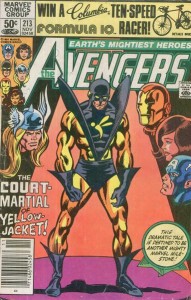 It’s important to remember that, by this time, nearly two decades after Ultron’s first appeared, Hank Pym had become a broken man, and was now reassembling himself. He’d lost his mind… several times. He’d suffered a psychotic episode shortly after regaining the memories the first Ultron had wiped from him. He’d changed his code name to Yellowjacket and finally married Janet Van Dyne, something the “old” Hank had been afraid to do. And he’d done all right for himself for a while. Then Ultron had shown up and wiped his mind again. It wasn’t too long after that episode that Hank had begun exhibiting paranoid behavior, and, losing his temper, had given his wife Jan a black eye.
It’s important to remember that, by this time, nearly two decades after Ultron’s first appeared, Hank Pym had become a broken man, and was now reassembling himself. He’d lost his mind… several times. He’d suffered a psychotic episode shortly after regaining the memories the first Ultron had wiped from him. He’d changed his code name to Yellowjacket and finally married Janet Van Dyne, something the “old” Hank had been afraid to do. And he’d done all right for himself for a while. Then Ultron had shown up and wiped his mind again. It wasn’t too long after that episode that Hank had begun exhibiting paranoid behavior, and, losing his temper, had given his wife Jan a black eye.
The Avengers court-martialed him. Jan divorced him. It was an abrupt and very badly-written storyline. All the Avengers behaved in ways that conflicted with their established characters. Even as a piece of propaganda against domestic violence it failed, because domestic violence is not about a one-time psychotic break brought on by the actions of killer robots. It’s about ongoing emotional and physical abuse and humiliation, the systematic destruction of a person’s dignity and defenses. The story made no “statement,” other than, “We want to say something about domestic violence… by writing a story that bears no resemblance to the reality of the problem.”
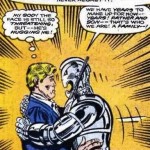 Ultron Mark 12, who wanted to be called “Mark,” was able to reach Hank on an emotional level precisely because Hank was now a man who’d lived through terrible adversity, had lost everything he loved, and somehow survived. He was a stronger man than he’d ever been, and a huge part of strength is compassion. Having an intelligent creature that he’d created come to him and say, “I want a second chance,” resonated.
Ultron Mark 12, who wanted to be called “Mark,” was able to reach Hank on an emotional level precisely because Hank was now a man who’d lived through terrible adversity, had lost everything he loved, and somehow survived. He was a stronger man than he’d ever been, and a huge part of strength is compassion. Having an intelligent creature that he’d created come to him and say, “I want a second chance,” resonated.
Mark’s conversion was genuine. He’d seen his father in battle against the Grim Reaper recently. He’d seen a man he’d known to be broken go into battle without the aid of any super-powers, trying to protect his friends. Mark felt admiration, and, aided by the enhanced processing power of his last robotic evolution, he overcame his hatred and realized he felt love for the first time. And here, Englehart gives the first-ever explanation of Ultron’s rage over the years. While Shooter and Thomas had talked about an “Oedipus complex,” that was never enough to explain Ultron’s hatred, at least to me. The Oedipus complex was meant by Freud to illustrate how hidden feelings can affect our conscious mind and behavior. It wasn’t mean to be viewed as a disease that you could catch, causing you to literally try to kill your father.
Mark explained to Hank that, like any developing intellect, he went through an adolescence. Like many male adolescents, he needed to prove himself as a “man,” and that meant measuring himself against the most familiar male role model. Like man insecure people, that also meant trying to defeat and belittle the role model, to look bigger by comparison. Mark was now matured beyond that. Sadly, Mark’s “brother,” Ultron 11, had survived the Secret Wars. He returned and brought Mark and Hank’s reunion to a tragic end.
Mark–Ultron Mark 12–wasn’t the incarnation of the character that lasted, but it was a fascinating investigation of the motives behind one of the most famous (now even moreso) Avengers villains. From here, he would go on to be pretty much a stock villain in other Marvel heroes’ titles, until Kurt Busiek wrote perhaps the most chilling, homicidal (genocidal?) version of the character in 1999. Here, Ultron, aided by yet another robot bride, Alkhema (also created by Roy Thomas during his run on West Coast Avengers), decimates a small Balkan nation. It’s a bloodier, more decisive attack than its parallel in the film Age of Ultron, and it establishes Ultron as probably the most truly evil character the team has ever faced.
The movie incarnation of Ultron has something the comics versions (except for Mark) sadly lacked–a sense of humor. James Spader’s incarnation of the living robot is a joy to watch. Comics movies being what they are, even with the great success of the Marvel Studios films, it’s unlikely we’ll see Spader return to play Ultron again. And that’s a shame. He brought the character to stunning life.

